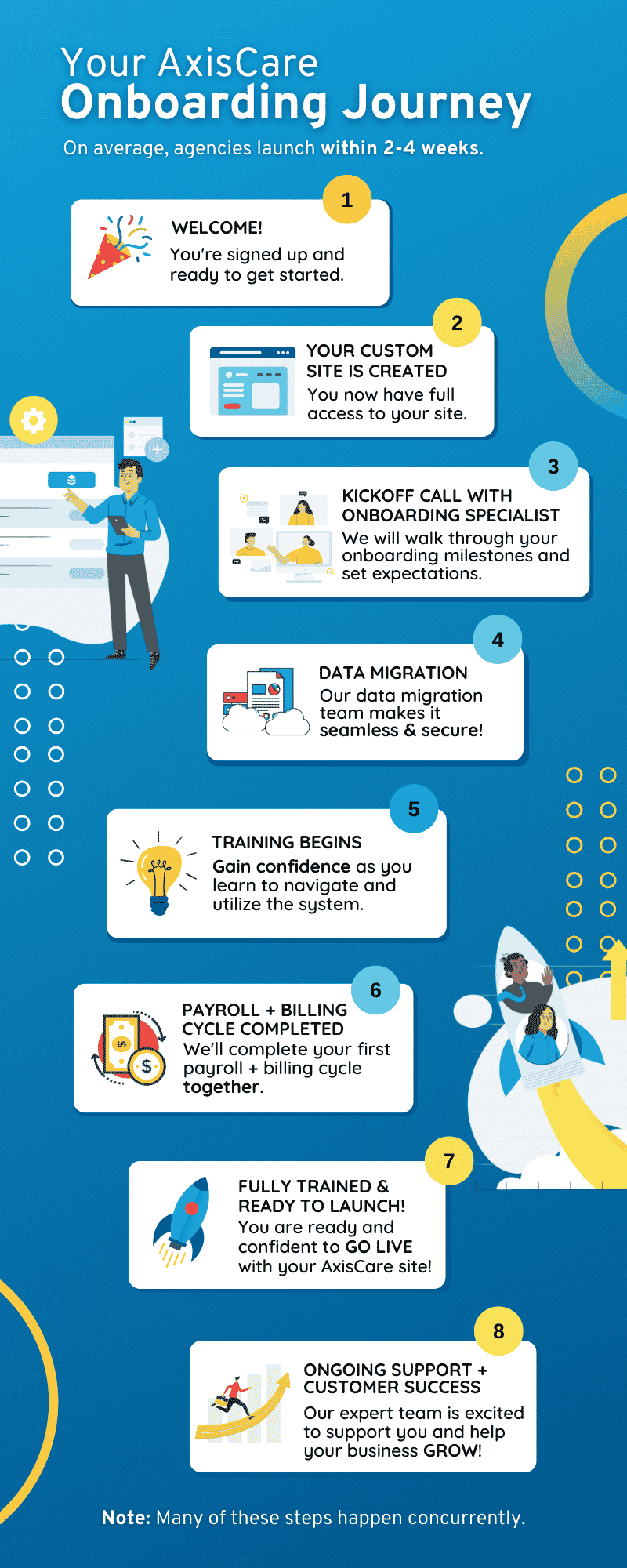Home health care is in a hiring crunch. In-home aides are among the most in-demand workers, with industry professionals projecting that an extra 7.8 million caregivers will be needed by 2026. That’s a 76% increase compared to 2014.
On the other hand, though, there is a marked shortage of caregivers, which has increased the cost of home health care service professionals over the past few years. As a result, many agencies are finding it hard to attract and keep the right talent.
With the home care employment market pulled tight as a drum, providing the right salary and benefits is essential for your agency’s survival and growth. In this piece, we’ll help you understand the current state of affairs so you can confidently determine your wages.
Understanding Caregiver Hourly Rates
Home care practitioners are typically paid by the hour, as opposed to a fixed annual salary. Lately, these rates have been rising – let’s explore the driving forces behind these changes.
Why Are Caregiver Wages Rising?
With demand for caregivers increasing and supply decreasing, it’s an employee’s market. Competitive salaries and benefits will likely be the most effective way for agencies to acquire and retain the best talent.
Labor Shortage
The economy is growing, and for that reason, caregivers can easily land better-paying jobs in other sectors, including hospitals. On the other hand, the population is aging, and many seniors are choosing to spend their sunset years at home.
The same forces are at play in the caregiver labor pool: currently, experienced home caregivers are aging out of the workforce. This type of role is physically and emotionally demanding, and many are simply not interested in caregiving careers, leaving agencies with fewer options.
Minimum Wage Hike
The minimum wage for home caregivers can vary widely depending on the state or even local jurisdiction, but more than 24 states, including New Jersey, Oregon, and Chicago, have raised their benchmark to $15. Following the House ruling in July 2019, all states are required to have raised their wage floor to $15 by 2024.
The pay hike may be a victory for low-income workers, but it has presented agencies with multiple challenges regarding reimbursement, hiring, and retention. How do you pay your workers more while preserving your bottom line?
The seemingly quick and easy answer would be to increase client fees. But that’s not possible in every case, especially when services are paid by Medicare and Medicaid.
Location & Cost of Living
It’s essential for an employee’s pay to reflect their cost of living. Someone working in the middle of a large metropolitan area will likely have significantly higher expenses than someone living and working in a more rural area.
That being said, there are small but important exceptions to that rule. For example, the big-city caregiver may be able to take public transit to and from work, while the more rural caregiver may have to purchase and maintain a vehicle.
Experience & Training
It’s essential for an employee’s pay to reflect their cost of living. Someone working in the middle of a large metropolitan area will likely have significantly higher expenses than someone living and working in a more rural area.
That being said, there are small but important exceptions to that rule. For example, the big-city caregiver may be able to take public transit to and from work, while the more rural caregiver may have to purchase and maintain a vehicle.
Average Caregiver Hourly Rates
National Average Rates
According to a Talent.com survey of 10,000 caregiver jobs in the United States, the average salary nationwide is $29,253 per year, or just over $14 per hour. Entry-level roles begin closer to $26,000, whereas senior positions can earn closer to $37,000.
Regional Rates
The same Talent survey revealed that Vermont, Rhode Island, and Alaska pay the highest average caregiver salaries, hovering between $38,000-39,000 per year. Mississippi was at the very bottom with a $21,450 average salary, followed by Louisiana and Alamaba in the $23,000 range.
How it Affects Recruitment & Retention
High Turnover Rates
Caregiver turnover rates have long been a dilemma for in-home care agencies. According to the 2023 benchmark study by Activated Insights, the median turnover rate soared from 65% in 2021 to 77% in 2022 – the highest it’s been in five years. It’s more important than ever for agencies to keep a close eye on employee happiness and get ahead of a potential turnover wave.
Competitive Advantage
If you can’t offer salaries that are as high as your competitors, ramp up the benefits – from paid time off and performance bonuses to prepaid gas cards. Historically, training opportunities and stronger benefits have helped flatten the curve of high attrition in the home caregiving sector.
There has also been a strong correlation between office staff and caregiver turnover; agencies that retain office staff for longer have lower attrition rates for caregivers, potentially due to a higher capacity for day-to-day employee support.
Quality of Care
Well-paid workers are motivated workers. If caregivers feel they are being properly compensated for their work – whether it be through pay, benefits, or opportunities – their satisfaction will be reflected in the quality of their care. On the other hand, if morale begins to slip, employees may begin to feel apathetic, deflated, and therefore less energized in their day-to-day work.
How to Negotiate Caregiver Hourly Rates
As mentioned previously, a massive demand for home caregiving services is currently pressing up against a shortage of workers. There is competition not only from other home-care agencies but also from employers in other sectors that pay better wages.
When deciding home care caregiver wages, consider your workers’ value in client experiences and their impact on smoother company operations and growth ambitions. Realize that when a single caregiver quits, it can cost you more than $14,000 from disrupted operations to missed shifts, new hiring costs, and impacted client experiences.
Can’t afford to pay much more but still want to bump up your compensation? Here are 47 ideas for non-monetary employee benefits!









